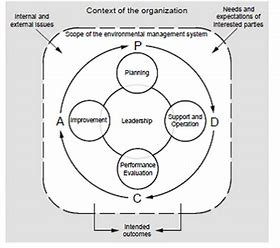Environmental Management Systems: Achieve and Exceed Regulatory Compliance
October 4, 2018 · Commercial, State, Municipal ·As part of a new series, Bay West’s environmental compliance expert, Wendy Tindall, offers readers insights on highly relevant environmental compliance topics. Ms. Tindall has over 17 years of experience working on environmental compliance services, including extensive regulatory expertise in air, waste, water, and tank regulations, permitting, and reporting.
In part one of this new series, we discussed the current political landscape and how state governments have become increasingly important in advocating and implementing stronger human health and environmental protection programs. To businesses, this means that you not only are still required to meet past environmental requirements, but increased scrutiny at the state level could mean your requirements have potentially increased.
In part two, we will discuss Environmental Management Systems (EMS) and how they can have a positive impact on a company’s regulatory compliance. If you would like to learn more about the implementation of an EMS, you can follow the link at the end of this article to an expanded version on the Bay West website.
The benefits of an effective EMS can be revealed by conducting simple on-site assessments or audits of various compliance areas applicable to the facility. These on-site assessments may even reveal that a facility’s existing policies and procedures may indeed already have the makings of a formal EMS if you just scratch under the surface. With some simple recommendations for improvements, a facility can be given the plan to activate their EMS and experience an immediate positive impact on their regulatory compliance.
What, exactly, are the benefits to a company for activating an effective EMS?
Keep in mind, an EMS is just one potential piece to the overall management approach of your company, which is why thoughtful consideration should be made from the beginning on how this one piece can best be embedded in your business practices. When this is achieved, the benefits are many, including:
- Better internal organization around assessment of environmental compliance (especially for organizations pursuing formal ISO certification 14001 or wish to meet these standards informally)
- Heightened awareness of product life cycle impacts on your operations
- Opportunity identification and execution, such as cost savings and waste stream reduction
- Continuous improvement – – always moving forward (or taking a step back, when needed!)
Environmental Regulatory Compliance in a Business Environment
Before we dive deeper into what an EMS is and how companies can integrate them, let’s quickly discuss how environmental regulatory compliance fits into the business environment. Let’s face it, our commercial, manufacturing, and industrial facilities can juggle several environmental regulatory compliance matters including, but not limited to, air emissions, stormwater discharge, wastewater treatment, hazardous waste management, chemical and oil storage, and management of on-site tanks. Rewards for achieving basic environmental regulatory compliance no longer exist because the public now expects businesses to follow the rules. Establishing an effective EMS can allow us to exceed expectations and move our facilities beyond basic compliance and achieve excellence.
How does an EMS work?
The U.S. Environmental Protection Agency states that an effective EMS uses the Plan, Do, Check, and Act cycle model to ensure that environmental matters are systematically identified, controlled, and monitored:
- Plan – How do I decide what to do and in what order? Plan a change by establishing new policies, objectives, processes, and procedures relevant to managing environmental compliance.
- Do – How do I do it? Implement and operate the policies, controls, processes, and procedures and test the change by evaluating the new system.
- Check – How are we doing? Assess and measure, if possible, process performance against the new policies, objectives, and practical experience. Report the results to management for review.
- Act – How can I make it better? Take corrective actions, based on the results of the assessment, to achieve continual improvement of the EMS.
Applying the Plan, Do, Check, Act cycle
Once an effective formal EMS system is established, companies can apply the Plan, Do, Check, Act cycle model to identify, control, and monitor numerous operations, such as:
- Developing a new or improved design of a process, product, or service
- Planning data collection and analysis to verify and prioritize problems or root causes
- Implementing any type of change
The Plan, Do, Check, Act model for a facility EMS ensures environmental matters and performance are continuously improved over time and allows facilities to keep ahead of applicable environmental regulations before enforcement or penalties become a reality.
This model should be used as a playbook only. Maintaining an effective EMS and continuously reviewing facility processes involves everyone taking responsibility, whether you are the one making the rules (developing the procedure) or the one obeying the rules (following the procedure). Consistent team communication and commitment to the plans your EMS contains are the keys to EMS success.
How does your company set about implementing an EMS?
 If your company has internal resources, you may be able to start the process on your own. We can help direct you to useful resources for this. There are benefits to bringing an outside consultant in to assist your facility with setting up or implementing an EMS. A trained compliance expert can give you an outside perspective, with the benefit of being removed from the day-to-day operations to identify potential gaps in the on-site operations, processes, and procedures. If you would like to learn more about ways to implement an EMS, whether on your own or with the benefit of an outside consultant, we can help.
If your company has internal resources, you may be able to start the process on your own. We can help direct you to useful resources for this. There are benefits to bringing an outside consultant in to assist your facility with setting up or implementing an EMS. A trained compliance expert can give you an outside perspective, with the benefit of being removed from the day-to-day operations to identify potential gaps in the on-site operations, processes, and procedures. If you would like to learn more about ways to implement an EMS, whether on your own or with the benefit of an outside consultant, we can help.
For those who are seeking ISO 14001 certification, we have also developed an EMS conformance audit checklist to evaluate how the formal facility EMS is performing according to the new ISO 14001 2015 Standard. We have the resources (ISO 14001:2015 Certified Lead Auditor training) to help companies review their formal EMS and how it conforms to the ISO 14001 2015 Standard.
Conducting a baseline environmental compliance assessment or audit of your facility can help determine problem areas and may expose programs already in place to solve most environmental compliance issues. Periodic internal facility regulatory compliance assessments and audits are essential to identifying, controlling, and monitoring how the facility processes and procedures are working.
